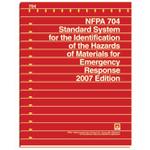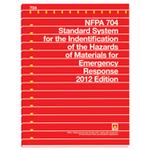Codes and standards published by NFPA are displayed as read-only under license from NFPA solely for use within this system. NFPA material may not be downloaded, printed, reproduced, or transferred.
Help safeguard personnel and the public from fire risks and hazards with the recognized marking system in the 2022 edition of NFPA 704, Standard System for the Identification of the Hazards of Materials for Emergency Response.
NFPA 704, Standard System for the Identification of the Hazards of Materials for Emergency Response, simplifies determining the degree of health, flammability, and instability hazards of chemicals – it also provides for the recognition of water reactivity and oxidizers.
The NFPA® “hazard diamond” provides an immediate general sense of the hazards of a material and the severity of these hazards as they relate to emergency response. This simple, readily recognized system of markings is based on NFPA 704.
Professionals utilize this system to:
- Supply appropriate signals and vital information to protect the public and private emergency response personnel
- Help plan for efficient fire and emergency control operations
- Aid designated personnel, engineers, and plant and safety personnel in assessing hazards
This standard is essential for manufacturers and users of hazardous chemicals, emergency responders, AHJs, building designers and inspectors, and consultants specializing in hazard identification and mitigation.
In the 2017 edition of NFPA 704, Annex G was added to explain the key differences between OSHA HazCom2017 and NFPA 704. The new annex clarified why the NFPA 704 rating system would remain unchanged by the implementation of HazCom2017.
The 2022 edition of the standard includes revisions to Figure 9.1(b) and Figure 9.1(c) that provide guidance on NFPA 704 placards, numeral dimensions, and size requirements.
Stay up to date and help keep workers safe from fire hazards and explosions by ordering the 2022 edition of NFPA 704, Standard System for the Identification of the Hazards of Materials for Emergency Response. (Print, 36 pp., 2022)
Product Details
- Published:
- 11/03/2020
- ANSI:
- ANSI Approved
- Number of Pages:
- 34


